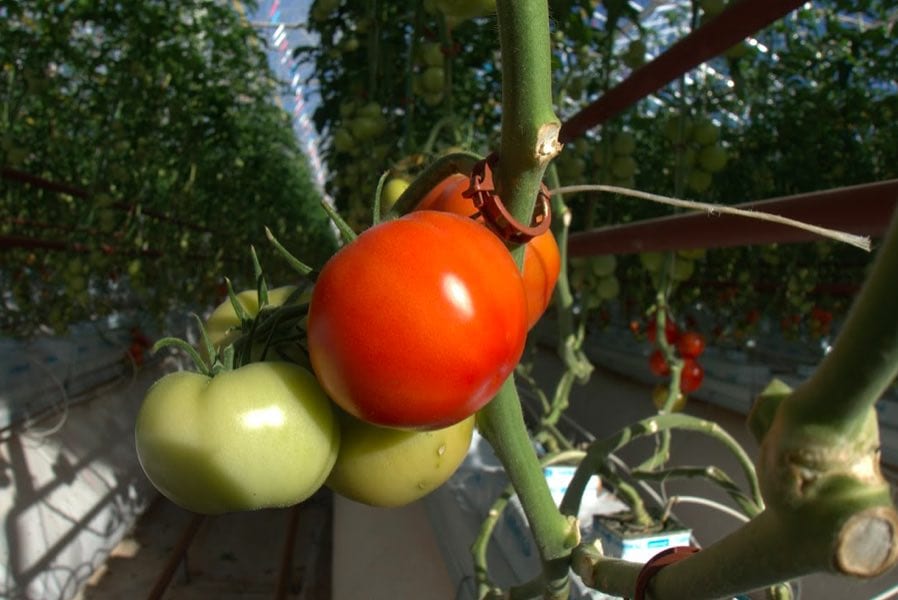The first thing you see on approach to Sundrop Farms is the 127m tall central solar power tower rising up from the desert floor. Lit like a beacon, it is illuminated by the radiance of 12.5 hectares of mirrors reflecting the sun on to its collector.
For some 300 days a year it shines on the tomato farm near Port Augusta at the northern end of South Australia’s Spencer Gulf, and the very idea of growing tomatoes in red dirt that supports little more than saltbush borders seems an act of defiance.
Yet this is exactly what Sundrop Farms does. Some 13,500 tonnes of tomatoes are grown annually with just sunlight and seawater, and it accounts for more than 10 per cent of the country’s truss tomatoes.
The thermal solar tower has a “thermal” rating of 39MW, but only 1.5MW for electricity. The desalination unit produces pure water to irrigate the crops, and the heat and carbon dioxide keep the tomatoes in the optimum atmosphere to facilitate year round photosynthesis.
CEO Stephen Marafiote explains that the concept is built from components of pre-existing technologies: the energy system is from Denmark and the US, the turbines from Germany while the semi-closed greenhouses, the most advanced in the world because they can be cooled as well as heated, are from Holland. “Each of these is proven technologies but the way they work together is the innovation here.” he explains.

Marafiote says Sundrop Farms was built with food security in mind. “As we see climate change and as we see continued pressure on agricultural land – there are a number of issues that add up to food security.” This, he says, is a legacy issue: sites of major towns were historically chosen because of their excellent agricultural land.
As they grew into modern cities, the prime land was taken over. Furthermore, an increasing population means greater demand for food. Sundrop’s technology addresses this shifting equation because it does not require soil and the tomatoes can be grown with minimal inputs. The harsh conditions of the Australian desert is a test of the concept.
Sundrop Farms was intended as much to be a demonstration as a viable business: “That’s why I agree to do interviews because we wanna share,” Marafiote says. The company – helped by a Clean Energy Finance Corp loan to get started, and now owned by Morrison & Co, is financially stable, he says, and has a 10-year contract with Coles.
And while he concedes that the technology here is customised for this location and the crop and so may not be suitable for every application, “in third world nations where you have scarcity of resources our operation can operate well.”
And why tomatoes? Marafiote also hints that Sundrop’s tech is anticipating another problem: increasing scarcity of freshwater. “Every litre of water you put into a tomato farm you can produce the highest calorific supply for food nutrition to an individual so for a third world nation that’s really important.” he says, and tomatoes are healthy. “We’re not giving them a chocolate bar.”
Inside the fifty hectares of greenhouses are rows of tomatoes hanging off PVC pipes more like vines than plants. “End to end it would be 106 kilometres,” says Marafiote, who comes from multiple generations of fresh food producers.
The tomatoes from here are allowed to ripen on the plant so receive the salts and sugars. Many other producers pick the fruit while green and let them ripen in the box, a process that starves them of flavour. One reason why imported tinned tomatoes are still so popular.
Sundrop employs advanced tech and feels more like a lab than a farm. Through the roof, you can see the solar tower that radiates reflected sun onto plants. In fact, more is required to grow these tomatoes than just sun and seawater. Rocks of yellow sulphur are used as a nutrient while introduced insects keep away pests like the notorious whitefly that are battled in greenhouses throughout the country.
While boxes of tomatoes are ferried around with driverless vehicles, labour is still another vital input. Sundrop Farms employs 300 people sought both from the surrounding towns like Port Augusta, Port Pirie and Whyalla, but also through the government’s Pacific Labour Scheme – “we like the social impact it has back in those countries.”
On my way out, sample tomato in hand, Marafiote explains that he expects demand to increase, although he cannot say how much because of commercial confidentiality. After potatoes, tomatoes are the fruit/vegetable most consumed by Australians. During the panic buying last year canning plants at SPC were working 24 hours a day to meet demand for tinned tomatoes.
COVID has also increased awareness of the fragility of long global supply chains, raising the concept of food sovereignty into the national discourse, a conversation that is likely to be ongoing. All this means that Sundrop Farms is likely to achieve their goal of continued growth and we may even see more similar operations replicated elsewhere, in Australia and throughout the world.
Back at the hotel I quarter my plump tomato and dust it with a half turn from the pepper grinder. It is a bold red, the same ruby insides as the tomatoes I grew at home. Those were ready to pick by later summer while these are ready now, with next week winter starting.
The quarter tastes good. There is more flavour and it is juicer than most of those that you might find in a supermarket chain. Till now, I had opted for imported tinned tomatoes as I found those grown here disappointing. They’re even almost as good as the ones I grew at home.









